
views
X
Trustworthy Source
World Health Organization
Health information and news provided by the World Health Organization.
Go to source
Make small changes to your diet over the course of a few weeks as opposed to many drastic changes at once, and you'll be able to sustain a healthier way of eating and enjoy the health benefits of a healthy diet.
Plan & Prep
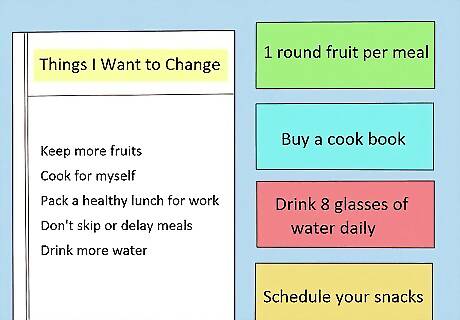
Set a goal for yourself. Starting a healthier diet is a great overarching goal; however, to make your goal more realistic and doable, you'll need to be more specific about what you want out of a "healthy diet." It might be helpful to first think about your current diet. What's unhealthy about it? Do you need to eat more green vegetables? Do you need to drink more water? Should you snack less? Write up a list of the things you want to change, add or stop about your current diet. Use these ideas to form multiple small goals to help you reach a healthier diet. The best way to reach any goal is to start with one or two very small changes. Trying to overhaul your entire diet in a few days probably won't work well. Choose something small to work on each week. You'll be much more successful long-term.
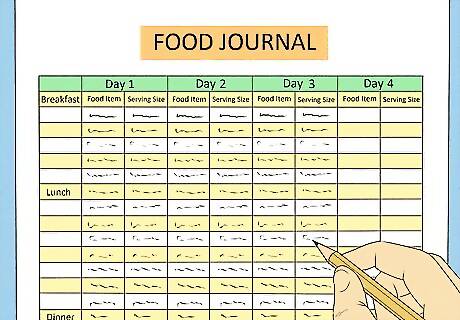
Start a food journal. After you've come up with a few goals and how you can achieve them, consider starting a food journal. This will serve as a method to track and evaluate your progress. Write all your goals in your food journal. You can review them as needed or change them as you continue to make changes to your diet. Also track all of your foods and beverages in your food journal. This will help you physically see what's missing from your diet or what you're eating too much of. Make sure to write out each breakfast, lunch, dinner, snack (even a few nibbles) and drinks you consume throughout the day. The more accurate you are, the better resource this will be. Each week in your food journal, write down the change you want to work on. For example, "This week, I will drink eight glasses of water each day." At the end of the week, go back over your journal to see if you've completed this goal. There are many apps available to download on your smartphone that can help you track calories, exercise, and even how much water you drink.
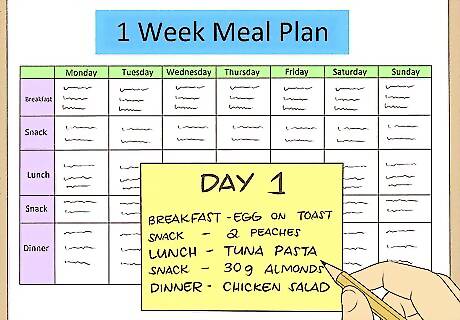
Create a meal plan. A meal plan is a great tool when you're trying to follow any new diet plan. These plans are your guide and blueprint to your week of meals and snacks. Meal plans can help you stay organized and on track throughout the week. You'll know exactly what you're going to have and on what day. This way you can go to the grocery store with a specific list, only buying what you plan to use in your meals for the week. You can also plan ahead of time for busy days — for instance, if you know you'll be very busy and work late on Thursday, make something on Wednesday that you can easily reheat and have for leftovers on Thursday. Also write up the corresponding grocery list to your meal plans. This will help you get in and out of the grocery store and ensure you have all the necessary ingredients at home to make all of your meals. Don't skip meals. If you currently skip meals, make sure to schedule a meal or a healthy snack for yourself at least every four hours. Skipping meals is more likely to lead to binge eating later, which contributes to weight gain.
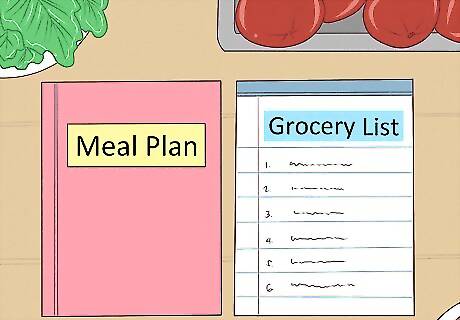
Meal prep in your free time. If you're busy and have little time to make a meal from scratch, meal prep will be the key to following your new healthier diet. Meal prep helps you get a lot of the work of cooking from scratch or cooking at home out of the way during free time. When it's time for dinner on a busy weeknight, you should have most or even all of the cooking already done. Plan a day or two during the week when you have some free time to do your meal prep. Review your meal plan and grocery list and try to find ways to get some cooking done. Meal prep is flexible. You can cook full dinners in advance so you just have to reheat the night you want to eat it, or you can just do washing or chopping of vegetables or marinating meat so you can quickly cook the night of. Also consider purchasing foods that require less prep work to begin with. For example, you can purchase pre-washed and cut bagged lettuce instead of a whole head of lettuce, frozen vegetables that are heat and serve, or pre-grilled lean protein like grilled chicken strips. Meal prepping can be a time to catch up with people. Ask your partner or children to help you prep while you talk about what has been going on in your lives.
What to Eat
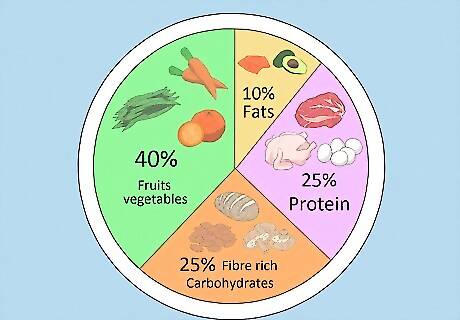
Go for a well-balanced diet. Although there is a variety of eating styles and diet plans to follow, the most nutritious is a well-balanced diet. A balanced diet will be different for everyone. You'll need to eat the right portion sizes for your age, gender and activity level. In addition, a well-balanced diet is one that features foods from each food group each day. Although many diets suggest giving up gluten, or giving up carbs or even avoiding dairy, all food groups offer beneficial nutrition to everyone. Only avoid food groups if you have an allergy to those foods. Also make sure you have a wide variety of foods in your diet. For example, don't always choose to eat an apple as your afternoon snack. Alternate between apples, bananas or berries to increase the variety of your diet.
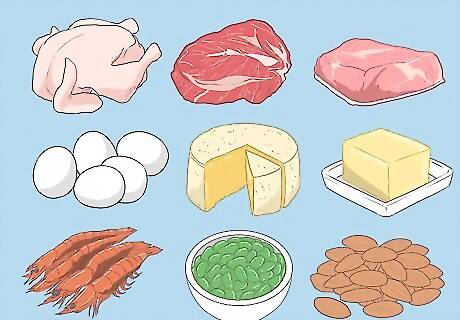
Choose lean protein over higher fat protein sources. Protein is an essential nutrient to any nutritious diet; however, choosing leaner protein sources is advisable. Protein is essential for a variety of functions in your body which includes providing your body with energy, supporting your lean muscle mass, providing the basis for many enzymes and hormones and providing structure and support for cells. Lean protein sources are lower in fat and calories compared to higher fat proteins. Many high-fat proteins (mostly from animal sources) are higher in saturated fat. Focusing on leaner protein decreasing your overall intake of these types of fat. To get your recommended amount of protein each day, include one or two servings at each meal. One serving is about 3 – 4 oz or about the size of the palm of your hand. Lean protein sources include poultry, eggs, low-fat dairy, pork, seafood, beans and nuts, and lower fat beef.
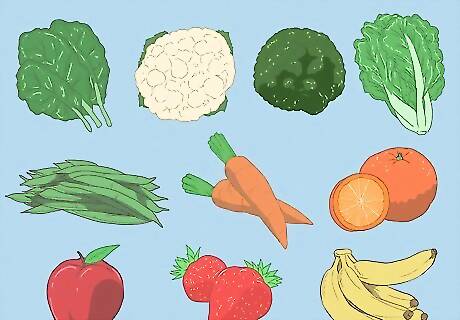
Find ways to include five to nine servings of fruits and vegetables each day. Fruits and vegetables are an integral part of a healthful diet. These are the foods that are abundant in essential nutrients. Fruits and vegetables are both fairly low in calories, but high in nutrients (making them nutrient-dense foods). They are some of the best sources of fiber, vitamins, mineral, and antioxidants. It's typically recommended to consume five to nine servings of fruits and vegetables each day. So measure out 1 cup of vegetables, 2 cups of leafy greens and 1/2 cup of fruit to help you meet this recommendation. If you don't typically eat a lot of fruits or vegetables now, increasing your intake to five to nine servings daily can be difficult. Find easy ways to get in a few of these essential foods. Try: mixing in sautéed vegetables into eggs for breakfast, sprinkle yogurt or cottage cheese with fruit, add extra lettuce, tomatoes, and onions to your sandwiches, or try adding some steamed vegetables to your mac and cheese recipe.
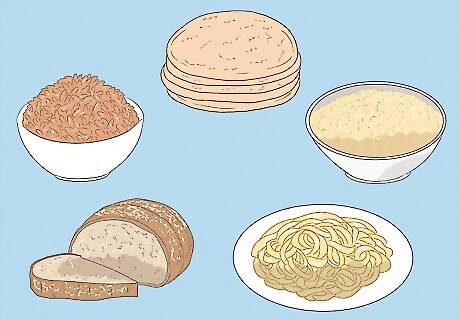
Choose whole grains over refined grains. An easy way to increase your nutrition and eat a healthier diet is by choosing 100% whole grains. These foods are much better for you than refined grains. 100% whole grains have all three parts of the grain — the germ, bran, and endosperm. They are less processed and contain many more nutrients like fiber, protein and minerals. Refined grains are much more processed than whole grains. They are typically stripped of the bran and germ so they are lower in fiber and protein. Avoid foods made with white flour — like white pasta, white rice, pastries, chips and crackers. Include a few servings of whole grains each day. Measure out a 1 oz or 1/2 cup serving to help you stick to appropriate portion sizes. Try whole grains like quinoa, brown rice, whole wheat pasta, millet, farro or whole wheat bread and wraps.

Choose healthy sources of fat. Although fat should be monitored in your diet, there are a few types of fat that are particularly healthy and provide a variety of health benefits. If you're trying to eat more sources of healthy fats, make sure to swap them out for unhealthy fats. Do not add more fats — healthy or not — on top of a diet containing unhealthy fats. Omega 3 fats and monounsaturated fats are both great for your body. They have been shown to improve cardiovascular health and improve cholesterol levels. The best sources of these healthy fats are avocados, olive oil, olives, nuts, nut butters, canola oil, chia seeds, flaxseeds and fatty fish (like salmon, tuna and mackerel). Remember, though, that these may also have a high-calorie count, so be moderate. Many health professionals recommended eating fatty fish at least twice a week and including a daily source of other healthy fats.
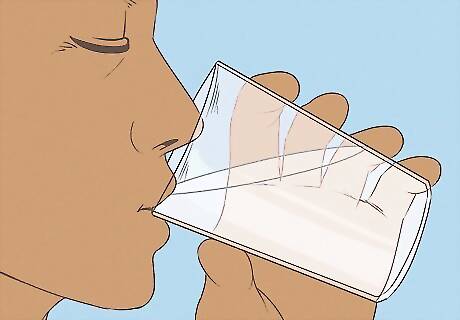
Drink adequate fluids. Although water is not necessarily its own food group or nutrient, it is an essential part of a healthy diet and a healthy body. Drinking adequate water every day helps your body stay hydrated. It's very important to help regulate body temperature, blood pressure and helps prevent constipation. It's typically recommended to consume at least eight 8-oz glasses (2 liters) of water daily. However, now many health professionals recommend consuming up to 13 glasses (3 liters) daily. In addition to water, you can try flavored water, decaf unsweetened coffee and tea. These beverages are no calorie and caffeine free which are the best and most hydrating fluids.
What to Avoid

Follow the 80/20 rule. Although you want to follow a healthier diet, it's still appropriate to indulge in your favorite foods. Following the 80/20 rule can help you stick to a healthy diet while eating more indulgent foods in moderation. Although eating a nutritious, well-balanced diet is important, it's not realistic to eat perfectly healthy every day for the rest of your life. People derive a lot of enjoyment out of eating and occasionally eating more indulgent foods. Treat yourself to an indulgent dish, glass of alcohol or larger portions occasionally. This is still considered normal and healthy eating; however, only indulge 20% of the time. Most of the time, or 80% of the time, you should be choosing healthy foods.
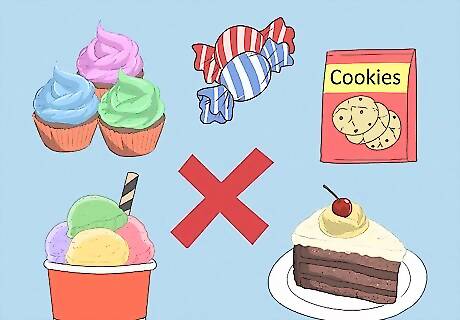
Limit sources of added and highly processed sugars. There are certain groups of foods that you should limit and only eat in moderation. Added sugars are something that should definitely be eaten in moderation as they often no nutritional value. Added sugars are added to certain foods during their processing. They offer no nutrition, only extra calories. In addition, many studies have shown that a diet high in added sugars can lead to obesity. Added sugars are found in a wide variety of foods. Try to limit items like breakfast pastries, cookies, cakes, ice cream, candy, and cereals. Also limit sweetened beverages. Not only are they high in added sugars and calories, but many people also don't think to count these types of drinks as a source of calories since they don't fill you up as much as food does. You may end up drinking more calories through these beverages. The American Heart Association recommends that women consume no more than 6 teaspoons and men consume no more than 9 teaspoons of added sugar daily.

Limit sources of unhealthy fats. In addition to added sugars, you should also limit certain groups of foods that contain high quantities of fat. In particular, you want to avoid higher levels of saturated and trans fat. There has been some controversy over whether or not saturated fat is as dangerous or unhealthy as previously thought. However, saturated fat is still a fat which means it's very calorie dense and if eaten in large quantities can still lead to weight gain and adverse health effects. You don't need to avoid all saturated fats, but do eat them in moderation. Especially foods like: full fat dairy, fatty cuts of beef or pork, deli meats and other processed meats. Trans fats have been directly linked to several adverse health effects like raising bad cholesterol levels and lowering the good kind, increases your risk for developing heart disease and stroke and increases your risk for developing diabetes. Try to avoid these foods as much as possible. Trans fats are found in a variety of foods including pastries, cookies, cakes, margarines, pies, fast foods, fried foods, baked goods, and soy sauce. There is no safe upper limit for trans fats. These should be avoided if possible.
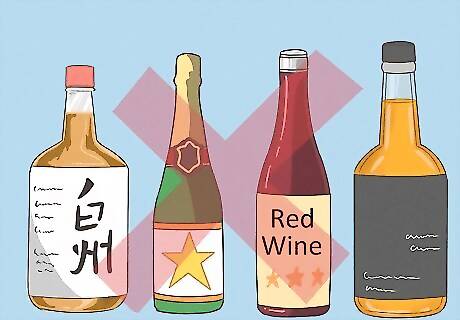
Consume limited amounts of alcohol. If you choose to drink, do so in moderation. Moderate amounts of alcohol generally do not pose health risks for most people. If you drink larger amounts of alcohol (more than three servings daily), you may increase your risk of high blood pressure, liver disease, heart disease stroke, and depression. Unlike some foods, there is a specific definition of moderate alcohol consumption. Women shouldn't drink more than one serving daily and men should consume no more than two daily. If you do drink, consider skipping mixed beverages that are mixed with sweetened beverages or fruit juices as these contain extra calories and added sugars. One serving is equivalent to a 12-oz beer, 5 oz of wine, or 1.5 oz of liquor.




















Comments
0 comment